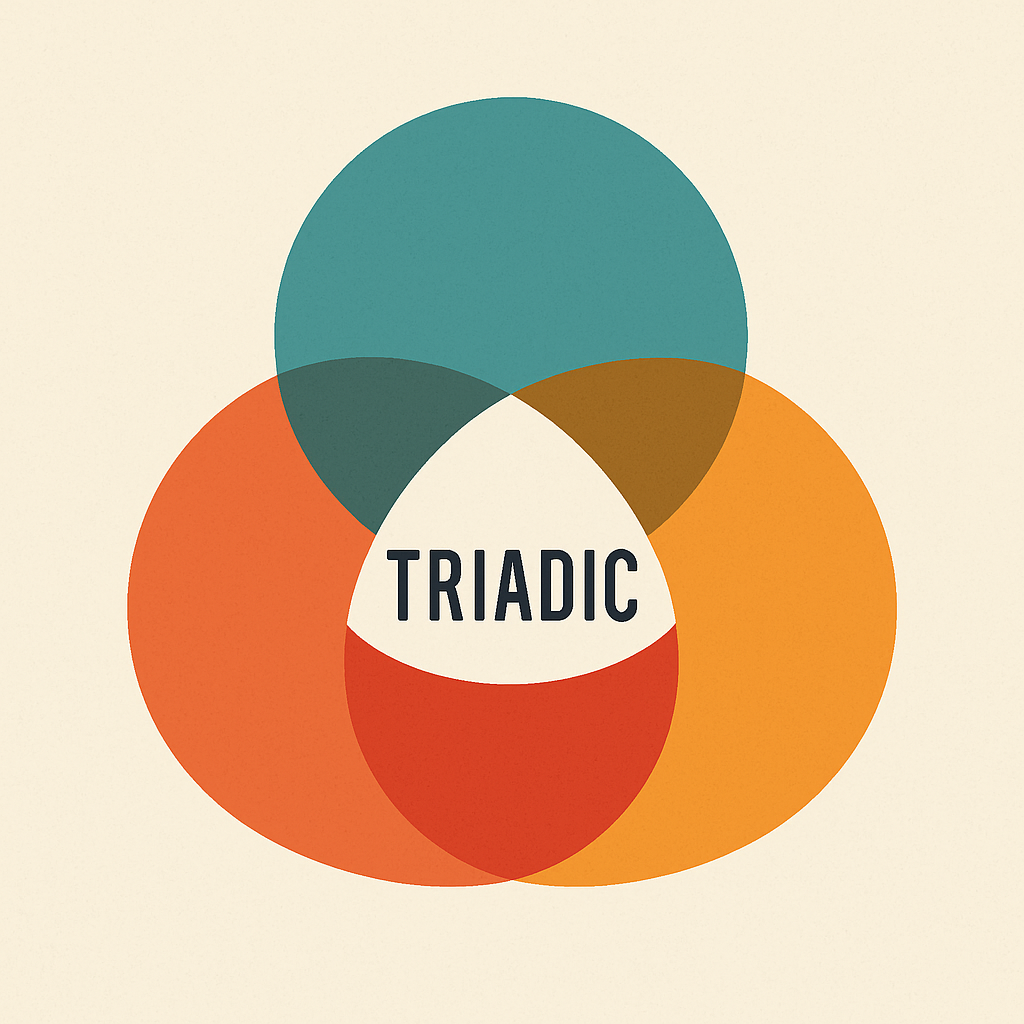Why understanding life in threes reveals more balance, depth, and meaning than a world of ones and zeros.
Introduction: The Limits of Either/Or Thinking
We live in a binary age. Our machines run on it, our politics depend on it, and our language reinforces it—yes or no, win or lose, right or wrong. The simplicity is seductive. Binary feels efficient. It gives the illusion of clarity.
But human experience is rarely that clean. Between light and dark there’s dusk. Between silence and noise there’s rhythm. Between success and failure there’s growth. We flatten the world into opposites and then wonder why it feels hollow.
The truth is, life isn’t binary—it’s triadic. Most of what we do, feel, and understand exists in threes. We move through time as past, present, and future. We perceive through visual, auditory, and kinesthetic channels. We live in cycles of beginning, middle, and end.
And yet, we keep forcing these natural triads into digital binaries. We reward extremes and ignore nuance. We build machines to think in twos, then model our own behaviour after them.
Understanding the hidden triad beneath our daily experiences helps restore a sense of balance—and meaning—that binary thinking quietly erodes.
The Brain’s Preference for Three
There’s a cognitive reason “three” feels complete. Neuroscientists have shown that short-term memory holds about three to four “chunks” of information before accuracy declines. Philosophers, storytellers, and mathematicians have long known this instinctively.
Three defines pattern. Two defines contrast.
Once a third element appears, we can see change. With three points, a line becomes a curve, a rhythm becomes a beat, and an idea becomes a system. It’s the smallest number that allows for complexity and coherence at once.
That’s why so many cultural forms rely on threes:
- The three-act structure of stories—setup, conflict, resolution.
- The rule of thirds in design—balance through asymmetry.
- The holy trinity in religion—unity through multiplicity.
Binary divides. Triads connect.
When you see the world through twos, you look for opposition. When you see it through threes, you look for relation.
How Binary Framing Shapes Modern Life
Binary logic runs deep. It powers our devices and influences our habits. Algorithms judge content as relevant or not. Digital systems store either a one or a zero. Even our social media platforms reduce sentiment to likes and dislikes.
This conditioning bleeds into human judgement:
- Success or failure. You either win or lose.
- Productive or lazy. You’re in motion or you’re not.
- Right or wrong. You align or you oppose.
Binary framing simplifies complex realities into emotional reflexes. It rewards speed and polarity at the cost of nuance and growth.
But there’s always a third dimension quietly missing: the process—the “becoming” between the poles.
That’s where actual learning, empathy, and transformation live.
The mind that learns to notice the “third” stops reacting and starts reflecting.
The Triadic Nature of Time
Our experience of time itself is triadic—past, present, and future.
We live in the present, informed by the past, and oriented toward the future. Each phase depends on the other two. Memory without presence is nostalgia. Presence without direction is drift.
Binary thinking traps us in false choices:
- Live in the moment or plan ahead.
- Forget the past or dwell on it.
But time isn’t a toggle switch. It’s a flow.
A triadic view lets us move fluidly between memory, attention, and intention—extracting meaning from each. It reminds us that growth is temporal integration, not emotional amputation.
As VAKIETA would phrase it, perception (the present) integrates input (the past) and expresses output (the future). The system learns through loops, not lines.
Communication: The Original Triad
Every act of communication involves three essential elements:
- Expression – what’s said or sent
- Interpretation – how it’s received
- Context – the shared frame that makes it meaningful
Binary models reduce communication to sender and receiver—message out, message in. But that model collapses without the contextual third.
The VAKIETA Communication Intelligence Framework treats this as foundational: every message passes through perception (how it’s sensed), interpretation (how it’s processed), and adaptation (how it’s adjusted). The loop never ends; it refines itself continuously.
When you see communication triadically, disagreement stops being conflict and becomes calibration. The focus shifts from “who’s right” to “what’s aligned.”
This triadic model doesn’t just explain communication; it mirrors cognition itself.
The Three Dimensions of Self
We tend to think of ourselves as singular identities, but our lived experience has at least three layers:
- The Physical Self – the body that acts and reacts
- The Mental Self – the thoughts that interpret those actions
- The Emotional Self – the feelings that give them meaning
Neglect one and the others distort. Over-focus on thought and the body atrophies. Live only through feeling and the mind becomes reactive. Chase physical pleasure without reflection and meaning evaporates.
Triadic awareness of self—body, mind, and emotion—creates balance. It grounds us in feedback, not judgment.
Binary self-assessment says, “I’m good or bad today.” Triadic reflection says, “My energy, thoughts, and feelings are interacting in these ways.”
One narrows consciousness; the other expands it.
Decision-Making: Data, Emotion, Action
We often frame decisions as rational or emotional, but that’s a false binary.
Effective choice requires three active elements:
- Data – the factual base
- Emotion – the motive energy
- Action – the behavioural follow-through
Remove any one and the system fails.
- Data without emotion produces paralysis.
- Emotion without data produces chaos.
- Either without action produces regret.
Understanding this triadic structure clarifies why most plans fail: they overvalue one mode and ignore the rest.
Seen through the VAKIETA lens, this triad resembles the Input–Integration–Expression cycle. The choice is not between data and emotion—it’s the synthesis that leads to intelligent action.
Work and the Cycle of Three
The workday itself is naturally triadic: plan, do, review.
Skip planning and you stumble. Skip doing and you dream. Skip reviewing and you repeat mistakes.
Modern productivity culture tends to glorify “doing” as the only meaningful phase. That’s binary thinking again—busy or lazy, productive or idle.
A triadic model of work values rhythm over speed. It treats reflection as part of motion, not its opposite.
Just as VAKIETA tracks feedback loops to refine communication, triadic work cycles close their own loops—turning effort into progress rather than noise.
Relationships: The Space Between
Relationships aren’t dual either. They’re triadic systems made of self, other, and the dynamic between.
Most relationship problems arise from treating them as binaries—my needs versus yours. But the third element, the relationship itself, has its own health and requirements.
You can think of it as an entity that needs care: attention, renewal, and boundaries. When both individuals support the third, equilibrium emerges. When they polarize, it collapses.
This applies equally to personal, professional, and even human–machine relationships. The third space—the interaction—defines the quality of connection.
Learning: Knowledge, Skill, Wisdom
We mistake learning for accumulation, but mastery is triadic:
- Knowledge – knowing what
- Skill – knowing how
- Wisdom – knowing when and why
Binary thinking fragments this: we measure test scores (knowledge) and ignore timing (wisdom). The result is competence without clarity.
Triadic learning integrates theory, practice, and judgment into continuous refinement. It’s how intelligence matures—from static memory to dynamic application.
Technology and the Binary Trap
Computers, at their core, are finite state machines. They operate on binary logic—ones and zeros, on and off. That architecture made sense for silicon, but not for humans.
The danger lies not in the technology but in the transference: we start to think like our machines. We interpret nuance as error, uncertainty as failure, and change as instability.
Yet the next wave of computation is already moving toward triadic and multivalued logic. Quantum systems use qubits and even qutrits—states that can hold multiple superpositions. AI frameworks like VAKIETA model communication not as dual but as adaptive triads: expression, perception, and feedback.
We’re beginning to teach machines to think more like us—not in binaries, but in continua. The irony is that we must first remember how we think ourselves.
The Third Way: From Opposition to Synthesis
Binary framing fuels conflict because it frames difference as threat. Triadic awareness reframes it as potential.
In philosophy, this shift is ancient: thesis, antithesis, synthesis. In psychology, it’s integration. In communication, it’s alignment.
When you add the third element—whether context, process, or reflection—polarities stop being enemies and start being forces in motion.
That’s the essence of systems thinking. That’s how VAKIETA operates: it doesn’t choose between styles of perception or processing; it maps their interaction to improve adaptation.
Triadic thought is less about balance and more about flow. It restores movement where binary thought freezes into judgment.
Reclaiming the Third Element
So how do we live more triadically in a binary world?
- Pause before polarity. When faced with a choice, ask, “What’s the third element here?” It’s often process, timing, or perspective.
- Design feedback loops. Replace goals with cycles—plan, act, review. The loop is more human than the switch.
- Communicate for alignment. Don’t just send messages; adapt them. Listen for context, not just content.
- Think in layers. Recognize that self, system, and situation interact. Simplify without flattening.
- Teach nuance. Help others see that complexity isn’t chaos—it’s depth.
The third element doesn’t reject binary—it completes it.
Closing Reflection: The Return to Three
We’ve mistaken clarity for simplicity. Binary thinking gave us precision but stripped away texture. Triadic awareness returns that depth without abandoning logic.
Nature itself prefers threes—DNA’s codons, the states of matter, the phases of water, the cycle of life. Every process we call living requires interplay, not isolation.
To command the machines, we must first command the models we use to see. Binary thinking built them. Triadic thinking will teach us to live with them.
“The universe is not built on opposites, but on relationships.”
When we see the hidden triads—between self and other, cause and effect, signal and response—we rediscover a more human kind of intelligence: relational, adaptive, alive.
And that, perhaps, is the third path forward.
StayFrosty!


